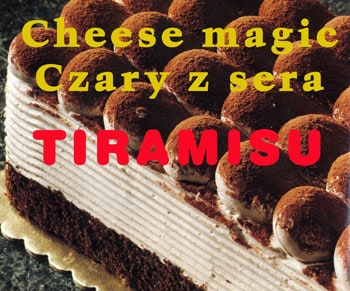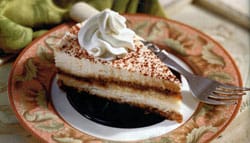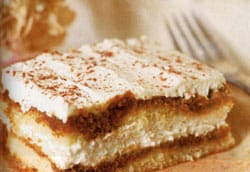

Cały świat zajada się tiramisu, od Seatle po Sydney. Często nawet nie mając pojęcia, że sekretem jego smaku jest włoski serek mascarpone.
Recipe for TIRAMISU:
200-300g of mascarpone cheese, 3 eggs, 3 spoons of sugar, and a pinch of salt; the sponge: 20-30 sponge biscuits, ( lady fingers } or home-made (ideally cocoa-flavor) cut into thin strips, two cups of strong coffee, 3 spoons of alcoholic drink (the Italians use sweet Marsala wine, but one can also use Amaretto, Grand Marnier, or Advocaat liqueur), powdered cocoa, and flaked chocolate.
Cream the yolks with the sugar, gradually add the mascarpone, and mix into a smooth mass. In a separate bowl beat the whites with a pinch of salt into a stiff foam. Gently combine the foam with the cheese cream. Mix the wine or liqueur with the coffee (dreg-free), add two spoons of water. Dip the sponge briefly into this mixture. Arrange the sponge at the bottom of a baking tin, spread the cream over this sponge base, and smooth with a spatula. Repeat, layer by layer. Leave a little cream to decorate the top. Sprinkle the surface with the cocoa powder and flakes of chocolate. The dessert should then be placed in a fridge for 6-12 hours, for the sponge do soak in the coffee and liqueur well. Tiramisu can be served with either chilled white wine or champagne.

The flavour of cheese depends on the grass and the herbs the animals feed on, as well as on whether the milk it comes from cows, sheep, buffalo, camels, or reindeer. Cow milk is sweetish and mild in taste. And so also is fatty mascarpone, obtained from the milk’s cream.
There are various stories of the cheese’s origin. In the official genealogy, it was born 300 years ago in Lombardy, northern Italy. Its family town is said to be Lodi, lying some 20km from Milan. That would explain the name of the cheese, as in Lombardy dialect the word 'mascarpia’ means ricotta, a soft cheese made from cream.
There are many uses for this cheese. In its home country, it is used as creamer for soups and main courses at dinner. Mainly, though, it is used for making cakes, creams, and desserts, the most famous of which is tiramisu.
It first appeared as a dessert served for the grand duke of Tuscany, Cosimo III of the Medici family. That was in the 17th century in Siena, where the duke – a lover of luxury and sophisticated dishes – was on an official visit from Florence. Because he enjoyed the dessert, it was given the name 'zuppa del duca’, or simply the duke’s soup. The recipe went with the duke’s court to Florence, the desserts fame soon reached Venice, and tiramisu immediately won the hearts of the local aristocracy and patricians. It was tucked into with a passion, especially during discrete suppers for two or just before trysts, as the duke’s soup was considered an aphrodisiac.
Modern science belies this claim, yet it does concede that certain products used for making the dessert (such as coffee or chocolate) do have stimulative qualities. Other ingredients high in fat, protein, and sugar content mean that tiramisu is a genuine calorie and energy bomb for the feaster. And so the dessert is not only delicious, but it also gives one vigour and puts one in an optimistic frame of mind. This is why, well over a hundred years ago, the Italians began calling it tiramisu: 'lift me up!

200-300 g serka mascarpone, 3 jaja, 3 łyżki cukru, szczypta soli, biszkopty: ciastka biszkoptowe ok. 20-30 albo biszkopt domowej roboty (najlepiej kakaowy) pokrojony w cienkie plastry, dwie filiżanki mocnej kawy, 3 łyżki alkoholu (Włosi używają słodkiego wina „Marsala”, można zastosować likier „Amaretto”, „Grand Marnier”, „Advocaat”), kakao w proszku, czekolada pokrojona na drobne strużki.
Ukręcić żółtka z cukrem, stopniowo dodawać serek mascarpone i powoli wymieszać na jednolitą masę. W osobnym naczyniu ubić białka ze szczyptą soli na sztywną pianę. Delikatnie połączyć pianę z kremem z żółtek i serka. Zmieszać wino lub likier z kawą (bez fusów), dodać dwie łyżki wody. Biszkopty moczyć (krótko) w tym roztworze. Na dnie formy, salatery lub kilku salaterek ułożyć biszkopty, posmarować je kremem i wyrównać łopatką. I tak kłaść warstwę za warstwą. Nieco kremu zostawić do dekoracji – można za pomocą szprycy ozdobić deser wzorkami. Wierzch tiramisu posypać kakao i wiórkami z czekolady. Następnie deser powinien trafić do lodówki na 6-12 godzin, żeby biszkopty dobrze nasiąkły kawą i likierem. Tiramisu można podawać z chłodnym białym winem lub z szampanem.
Historia sera
Podawane są różne wersje jego pochodzenia. W oficjalnej genealogii narodził się on 300 lat temu na północy Włoch, w Lombardii. Jego miastem rodzinnym jest ponoć Lodi, leżące 20 kilometrów od Mediolanu. Smak sera zależy od tego, czy mleko, z którego się go wytwarza, pochodzi od krów, owiec, bawołów, wielbłądów czy reniferów, a także od traw i ziół, którymi żywią się zwierzęta. Krowie mleko jest słodkawe i łagodne w smaku. I taki też jest tłusty serek mascarpone, otrzymywany ze śmietany. To wyjaśnia nazwę sera, jako że w dialekcie lombardzkim słowem „masearpia” określa się twaróg ze śmietany.
Serek ten ma wiele zastosowań. W rodzinnych stronach odgrywa rolę śmietany kremówki i dodawany jest do zup i dań obiadowych. Głównie jednak jest używany do sporządzania ciast, kremów i deserów, z których najsłynniejszym jest tiramisu.
Deser zadebiutował na stole księcia Toskanii Kosmy III z rodu Medyceuszy. Miało to miejsce w XVII w. w Sienie, do której z oficjalną wizytą zawitał florencki książę – miłośnik luksusu i wyrafinowanych dań. Ponieważ księciu deser zasmakował, nadano mu nazwę zuppa del duca, czyli „zupa książęca”. Jej przepis wraz z dworem trafił do Florencji. Fama o deserze szybko dotarła do Wenecji, a tiramisu natychmiast zawojowało miejscowy patrycjat i arystokrację. Zajadano się nim z namiętnością, zwłaszcza podczas dyskretnych kolacji we dwoje albo tuż przed schadzkami, bowiem uważano, że „książęca zupa” jest jednym z afrodyzjaków.
Współczesna nauka zadaje kłam temu stwierdzeniu, ale przyznaje, że niektóre produkty, z których przygotowuje się deser (jak kawa czy czekolada), mają właściwości pobudzające. Inne składniki o wysokiej zawartości tłuszczu, białka i cukru sprawiają, że delektując się tiramisu, pochłaniamy prawdziwą bombę kaloryczno-energetyczną. Deser więc nie tylko jest pyszny, ale daje wigor i nastraja optymistycznie. To dlatego Włosi już wieki temu zaczęli o nim mówić tiramisu, co znaczy „podnieś mnie do góry”
